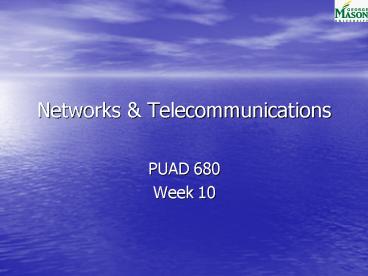Networks PowerPoint PPT Presentation
1 / 31
Title: Networks
1
Networks Telecommunications
- PUAD 680
- Week 10
2
Agenda
- Discussants
- Current events
- Alter 10, Networks Telecommunications
- Sawney Parikh
- Technology in the Washington State Park System
(A) - Alter 11, System Planning
- Sector surveys Krause, Tulipane
3
Figure 10.1
4
Figure 10.13
5
Wireless Transmission Figure 10.16
6
Telecommunications Standards
- De facto standards established by the fact that
a product dominates the market, e.g., Windows - De jure standards defined by industry groups or
by the government - Many de facto standards become de jure standards
7
- The OSI (open systems interface) model is a
framework for defining telecommunications
standards - Covers all aspects of network operations and
management - Developed by the International Standards
Organization (ISO) - Each level in the model is implemented through
protocols
8
Figure 10.18
9
- TCP/IP (Transmission Control Protocol/ Internet
Protocol) - Used on the Internet
- Five layer model
- HTML and HTTP are examples of application layer
standards - Open vs. proprietary standards
10
Standards Development Channels
- De Facto
- Voluntary
- Wrong choices
- Vendor captivity
- Uncertain
- Manipulation/gaming
- vaporware
- Example
- VHS/Betamax
- DOS/Windows
- PCL (printer control language)
- Voluntary Consortia
- Voluntary
- User or supplier based
- Small number of parties
- Fast development
- Example
- Infrared Data Association (IrDA)
- E-ZPass
11
Telecommunications Standards
- Telecommunication standards
- tradeoffs
- customization vs. interoperability
- proprietary vs. portable
- innovation vs. predictability
- competing standards
- OSI (Open Standards Interface)
- seven levels
12
Telecommunications Policy
- Anti-trust
- ATT breakup in 1984
- Competition for
- Local loop
- Cellular
- Microsoft case
- Spectrum allocation
- Historical ownership with renewal
- Content regulation
- Diversity/access/historical endowments
- Technical improvements increasing efficient use
of spectrum to point that scarcity is reduced. - FCC considering auctioning spectrum
13
Sawney Parikh
14
Technology in the Washington State Park System
(A)
- What difference does the choice of technologies
make to WSPRC? - What decision does Rita Cooper face?
15
IS Planning Development
- What is IS planning?
- Student experiences
- How is it different than IS development
- Student experiences with IS development
16
Importance of SystemPlanning Development
- IT enables/inhibits organizational performance
- Procedures constrain reasonable decisions
- New tower at National w/ old equipment
- IRS loses 2 billion
- FAA loses billions
- Public assumes agencies incapable
- But fault is with procedures
- Personnel
- Procurement
- Budget
- Role of political appointees
- Level of IT expertise
17
Challenge for Managers
- Awareness of invisible constraints
- Uphill battle even for savvy managers
18
What Is an Information Systems Plan?
- Information systems planning should be an
integral part of business planning - Business planning the process of identifying
the firms goals, objectives, and priorities
developing action plans for accomplishing them. - Information systems planning the part of
business planning concerned with developing the
firms information systems resources
19
Challenges in Business Planning
- Foreseeing and assessing opportunities
- Assuring consistency with organizational plans
and objectives - Building systems
- Maintaining information system performance
- Collaborating with IT professionals
20
Principles for IS Planning
- Support the firms business strategy with
appropriate technical architecture - Evaluate technology as a component of a larger
system - Recognize life cycle costs, not just acquisition
costs
21
- Design information systems to be maintainable
- Recognize the human side of technology use
- Support and control the technical system
22
Planning Role of the IS and User Departments
- The IS department is responsible for producing
the IS plan in conjunction with the user
departments - Chief information officer (CIO)
- Leads the IS function, and is responsible for
making sure that the IS plan supports the firm's
business plan
23
- User roles in IS planning roles
- Sponsors senior managers who make sure
resources are allocated for building and
maintaining the system - Champions individuals that recognize the
importance of an IS, and exert effort to make
sure that others share that recognition - IS steering committees make sure that the IS
reflects business priorities
24
Project Roles of IT Professionals
- Computer operators
- Database administrators
- System managers
- System programmers
- User support staff
- Project managers
- Application programmers
- System analysts
- Programmer-analyst
- Technical writers
25
Project Roles of IT Professionals
- Computer operators
- Database administrators
- System managers
- System programmers
- User support staff
- Project managers
- Application programmers
- System analysts
- Programmer-analyst
- Technical writers
26
Figure 11.3 Strategic Alignment of Business and
IT
27
Selecting Systems to Invest In
28
Cost/Benefit Analysis
- The process of evaluating proposed projects by
comparing estimated benefits and costs - Key issues
- Tangible and intangible benefits
- Tendency to understate costs
- Timing of costs and benefits
29
Risks
- Desired benefits are not achieved
- The project is late and/or over budget
- The systems technical performance is inadequate
- User acceptance is low
- Shifting priorities reduce the projects
importance, etc.
30
Financial Comparisons
- Some common criteria used for comparing and
ranking projects - Net present value (NPV)
- Internal rate of return (IRR)
- Payback
31
Project Management Issues
- Division of labor between the IS department and
users - Keeping the project on schedule
- Goals, deliverables, schedules
- Challenges in information system projects

